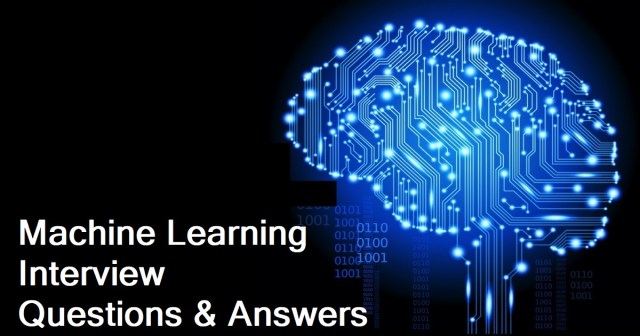Machine learning interview questions are an integral part of the data science interview and the path to becoming a data scientist, machine learning engineer, or data engineer. In order to help resolve that, here is a curated and created a list of key questions that you could see in a machine learning interview. There are some answers to go along with them so you don’t get stumped. You’ll be able to do well in any job interview (even for a machine learning internship) with after reading through this piece.

1) What is Machine learning?
Machine learning is a branch of computer science that enables systems to learn and improve from experience without being explicitly programmed. It involves developing algorithms that allow computers to make decisions based on data and patterns they learn over time.
Also Read Part 2 for more Machine Learning Interview Questions
2) What are the different types of Machine Learning?
- Supervised Learning: Learning from labeled data with guidance.
- Unsupervised Learning: Learning from unlabeled data without guidance.
- Reinforcement Learning: Learning through interactions with an environment, based on rewards and penalties.
3) Mention the difference between Data Mining and Machine learning?
Data mining focuses on extracting patterns from raw data, while machine learning involves the development of algorithms that enable computers to learn from data and make decisions.
4) Explain Classification and Regression?
- Classification: Assigning categories or labels to data points.
- Regression: Predicting continuous values based on input data.
5) What is ‘Overfitting’ in Machine learning?
Overfitting occurs when a model fits the training data too closely and captures noise or random fluctuations, leading to poor performance on new, unseen data.
6) Why does overfitting happen?
Overfitting happens when a model becomes too complex or has too many parameters relative to the amount of training data available.
7) How can you avoid overfitting?
- Use more training data.
- Apply techniques like cross-validation.
- Simplify the model architecture.
8) What is inductive machine learning?
Inductive machine learning involves learning from examples to induce a general rule or pattern.
9) What are the five popular algorithms of Machine Learning?
- Decision Trees
- Neural Networks (back propagation)
- Probabilistic networks
- Nearest Neighbour
- Support vector machines
10) What are the three stages to build hypotheses or a model in machine learning?
- Model building
- Model testing
- Applying the model
11) What is the standard approach to supervised learning?
The standard approach is to split the dataset into a training set and a test set.
12) What is ‘Training set’ and ‘Test set’?
- Training Set: Examples used to train the machine learning model.
- Test Set: Examples used to evaluate the model’s performance.
13) List down various approaches for machine learning?
- Concept vs. Classification Learning
- Symbolic vs. Statistical Learning
- Inductive vs. Analytical Learning
14) What is not Machine Learning?
- Artificial Intelligence
- Rule-based inference
15) Explain the function of ‘Unsupervised Learning’?
- Finding clusters in data.
- Discovering low-dimensional representations.
- Identifying interesting directions and correlations.
- Detecting novel observations and cleaning databases.
16) Explain the function of ‘Supervised Learning’?
- Performing classifications.
- Enabling speech recognition.
- Predicting time series.
- Annotating strings.
17) What is algorithm-independent machine learning?
Algorithm-independent machine learning refers to a mathematical foundation that’s independent of any specific classifier or learning algorithm.
18) What is the difference between artificial learning and machine learning?
Artificial learning involves developing algorithms based on empirical data behavior. Machine learning includes artificial learning but also covers other aspects of AI like knowledge representation and natural language processing.
19) What is a classifier in machine learning?
A classifier is a system that takes feature values as input and outputs a single discrete class label.
20) What are the advantages of Naive Bayes?
- Faster convergence compared to some models.
- Works well with less training data.
- Handles discrete and continuous data.
21) In what areas is Pattern Recognition used?
- Computer Vision
- Speech Recognition
- Data Mining
- Statistics
- Informal Retrieval
- Bio-Informatics
22) What is Genetic Programming?
Genetic Programming is an algorithmic technique used in machine learning to select the best choice among a set of results based on testing.
23) What is Inductive Logic Programming in Machine Learning?
Inductive Logic Programming (ILP) is a subfield that combines logical programming and examples to induce a general rule.
24) What is Model Selection in Machine Learning?
Model selection involves choosing the best mathematical model among several to describe the same dataset.
25) What are the two methods for calibration in Supervised Learning?
- Platt Calibration
- Isotonic Regression
26) Which method is frequently used to prevent overfitting?
Isotonic Regression is often used when sufficient data is available to prevent overfitting.
27) What is Perceptron in Machine Learning?
A Perceptron is an algorithm for supervised classification that assigns inputs to possible non-binary outputs.
28) Explain the two components of Bayesian logic programs?
- Logical component: Consists of Bayesian Clauses capturing qualitative structure.
- Quantitative component: Encodes quantitative information about the domain.
29) What are Bayesian Networks (BN)?
Bayesian Networks are graphical models used to represent probabilistic relationships among variables.
30) Why is instance-based learning algorithm sometimes referred to as Lazy learning algorithm?
Instance-based learning is considered “lazy” because it defers generalization until classification is performed.
31) What are the two classification methods SVM can handle?
- Combining binary classifiers
- Modifying binary for multiclass learning
32) What is ensemble learning?
Ensemble learning involves generating and combining multiple models to solve a computational problem.
33) Why is ensemble learning used?
Ensemble learning improves classification, prediction, and function approximation by combining multiple models.
34) When is ensemble learning used?
Ensemble learning is used when building component classifiers that are accurate and independent.
35) What are the two paradigms of ensemble methods?
- Sequential ensemble methods
- Parallel ensemble methods
Also Read Part 2 for more Machine Learning Interview Questions
This is very informative post.
Good Work